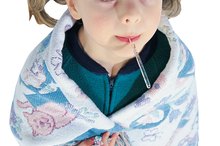Flu Symptoms in a 16 Month Old
The flu or influenza is an illness caused by a virus that affects the respiratory system 1. A 16-month-old toddler can get this virus from others who are infected as it is a contagious disease. Young children can develop complications from the flu that can be moderate to serious according to the Mayo Clinic 12. Symptoms can start slowly or abruptly. In most cases, medical intervention is not necessary. Keeping your toddler comfortable and monitoring her symptoms are two ways to help your child recover.
If you are experiencing serious medical symptoms, seek emergency treatment immediately.
Fever
A fever may be recognized as skin flushing of the face, chills, sweating but it can only be confirmed with a thermometer. The Mayo Clinic suggests a temperature of 103 to 105 degrees Fahrenheit is possible in children with the flu 12. A temperature over 98.6 degrees Fahrenheit is considered to be elevated but a fever isn't always a serious concern. Monitor your child's temperature and provide him plenty of fluids. When the immune system is fighting an infection a fever is often present. Seek medical care if convulsions or seizures accompany the fever.
- A fever may be recognized as skin flushing of the face, chills, sweating but it can only be confirmed with a thermometer.
Respiratory Symptoms
Causes of Kids' Breathing Problems
Learn More
Coughing, wheezing, nasal congestion or runny nose are all signs of the flu due to the impact the virus has on the respiratory system. A 16-month-old may benefit from saline nasal spray and a bulb syringe to help clear her nasal passages. Warm broth and other fluids will also help thin the mucus draining from the sinuses.
Aches and Pains
Headaches, muscle aches and general body weakness may affect a toddler with the flu states BabyCenter.com 2. Abdominal pain and cramping are possible and may be accompanied by vomiting and diarrhea.
Mood and Behavior
Infant Cold & Cough Relief
Learn More
Your toddler may be irritable, fussy, lethargic and may sleep more than usual. Toddlers may have a reduced appetite due to the general feeling of illness or the pain they are experiencing. Watch for signs of dehydration. Symptoms of this include dry mouth, dry eyes, crying without tears or infrequent urination.
- Your toddler may be irritable, fussy, lethargic and may sleep more than usual.
Related Articles
References
Writer Bio
Sarah Harding has written stacks of research articles dating back to 2000. She has consulted in various settings and taught courses focused on psychology. Her work has been published by ParentDish, Atkins and other clients. Harding holds a Master of Science in psychology from Capella University and is completing several certificates through the Childbirth and Postpartum Professional Association.









